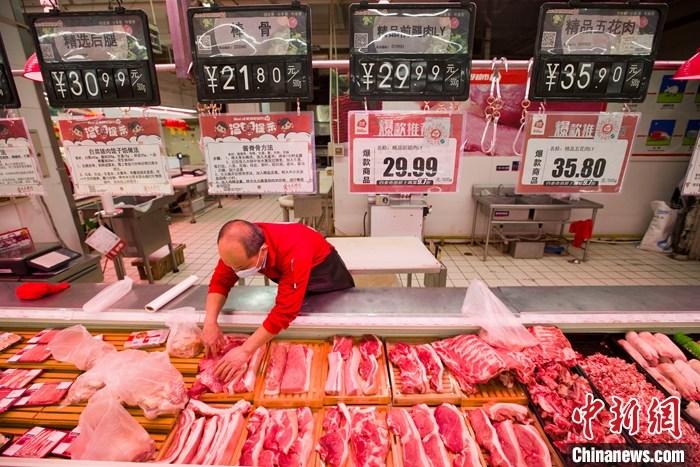China News Service, July 19th. Wan Jinsong, Director of the Price Department of the National Development and Reform Commission, pointed out on the 19th that as the central and local purchasing and storage "supporting the market" effect gradually appeared, and the number of newborn piglets decreased from January to February this year, after about half a year The fattening period will have an impact on the slaughter of live pigs from July to August. It is expected that the price of live pigs may continue to rebound in stages in the future.
Data map: In a supermarket, staff are sorting pork for sale.
Photo by China News Agency reporter Zhang Yun
On the 19th, the National Development and Reform Commission held a press conference.
At the meeting, a reporter asked that the price of live pigs continued to fall recently. The National Development and Reform Commission issued two consecutive warnings and initiated temporary purchases and storage in June. How is the progress?
What will happen to the price of live pigs in the future?
How to prevent price fluctuations?
How to ensure the supply and price stabilization of important livelihood commodities?
Wan Jinsong said that since the beginning of this year, due to the significant improvement in supply and the decline in demand, the price of live pigs has fallen sharply.
On June 2, the National Development and Reform Commission and the Ministry of Finance, the Ministry of Agriculture and Rural Affairs, the Ministry of Commerce, and the State Administration for Market Supervision jointly issued the "Improving the Government Pork Reserve Regulation Mechanism and Doing a Good Job in Maintaining Supply and Stabilizing Prices in the Pork Market."
After the announcement of the plan, according to market changes and in accordance with the plan, the National Development and Reform Commission issued two warnings about excessive fall in live pig prices on June 16 and 28, prompting farmers to make scientific decisions on production and operation.
After entering the first-level warning interval, the National Development and Reform Commission and the Ministry of Commerce and other relevant departments immediately started the purchase and storage of pork reserves.
On July 7 and July 14, two batches of central reserve purchasing and storage have been completed, and the third batch of central reserve purchasing and storage will be organized on July 21.
At the same time, the National Development and Reform Commission actively guides all regions to do a good job in purchasing and storage, forming a "supporting market" force and stabilizing market expectations.
At present, the excessive decline in live pig prices has been initially curbed. Since the end of June, prices have rebounded significantly. The current price has rebounded by more than 15% from the previous low. The pig-to-food ratio briefly fell below 5:1 and then rebounded quickly. It has risen to 5.85 last week. :1. The confidence of farmers has been restored, and the phenomenon of centralized slaughter has been eased.
Wan Jinsong pointed out that as the central and local purchasing and storage "supporting the market" effect gradually appeared, coupled with the decrease in the number of newborn piglets from January to February this year, after a fattening period of about half a year, it will have an impact on the slaughter of pigs from July to August. The price of live pigs may continue to rebound in stages in the coming period.
In the next step, the National Development and Reform Commission will continue to track changes in breeding sows and live pig stocks and pork price trends, release early warning information in a timely manner, and carry out purchases and storage in a timely manner to meet the requirements of the plan, and actively guide farmers to rationally arrange production. If necessary, it will further increase in cooperation with relevant departments. Great efforts will be made to regulate and adjust the price of live pigs and pork to prevent big fluctuations.
Wan Jinsong said that in terms of important livelihood commodities, the "Opinions on Improving the Price Control Mechanism for Important Livelihood Commodities" has been issued and implemented after the review and approval of the Central Deep Reform Commission. In early June, the National Development and Reform Commission held a national video conference to implement and do a good job. The work of ensuring the supply and stabilizing prices of people's livelihood commodities has been fully deployed.
A national price work conference was held from July 15 to 16 to redeploy the work of ensuring the supply and stabilizing prices of important livelihood commodities in the second half of the year.
In response to the rapid increase in the price of agricultural materials this year, the study put forward the opinions of one-off subsidies to grain farmers. After the State Council executive meeting reviewed and approved, the central government allocated 20 billion yuan of funds to be distributed to grain farmers as soon as possible.
With the joint efforts of all parties, positive progress has been made in ensuring supply and price stabilization. Recently, the prices of grains and oils nationwide have basically stabilized, and the prices of commodities such as meat, eggs, vegetables and fruits have dropped significantly from their highs at the beginning of the year.
Wan Jinsong emphasized that my country has another bumper harvest of summer grains this year, the production of "vegetable baskets" is advancing steadily, and there is a solid foundation for ensuring the supply and price stability of important livelihood commodities.
In the next step, the National Development and Reform Commission will work with relevant departments to pay close attention to the implementation of the "Opinions on Improving the Price Control Mechanism of Important Livelihood Commodities", and promote the establishment of "four beams and eight pillars" for the price control of important livelihood commodities, and make every effort to ensure sufficient supply and price of important livelihood commodities. Basically stable.

